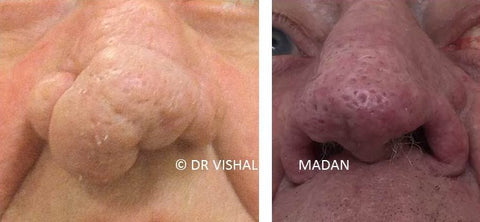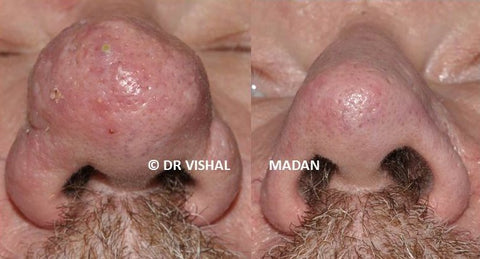Rhinophyma Laser

The nose being the centre most part of the face is also the most noticeable. Any deformity or even minor blemishes on the nose can be a cause of unnecessary distraction.
Rhinophyma refers to thickening of the skin of the nose and it is usually considered the last or most severe stage of acne rosacea. But many patients with rhinophyma may not have rosacea at all. Nearly all patients with rhinophyma will have oily or greasy skin. It is the thickening of the oil glands referred to as ‘sebaceous glands’ that leads to a build-up of ‘sebum’ and distortion of the skin of the nose. Rhinophyma occurs almost exclusively in middle aged to elderly Caucasian men but I have treated a few women and darker skin patients who had rhinophyma.
It is not uncommon for patients with rhinophyma to be stigmatised by their condition. Although there is little evidence to suggest the role of chronic alcoholism in rhinophyma, the term ‘whisky nose’ unfortunately almost always gets associated with this condition. I have seen many patients with rhinophyma who are teetotalers and most of my patients consume very little alcohol or drink in moderation.
Rhinophyma can be of varying severities. It can be classed as ‘minor’ if there is redness, broken blood vessels and mild thickening and coarsening of the nasal skin texture. Patients often complain of oily skin and on squeezing the skin of the nose, oily secretion ‘sebum’ can be expressed from the pores. Some patients may complain of whitish discharge often with offensive odour from the pores of the nose.
On the other hand, a major or severe rhinophyma is one which has prominent lumps on the nose leading to distortion of the architecture of the nose and may also lead to obstruction of nasal passages, and breathing difficulty.
Most patients have medium rhinophyma, severity of which lies between the minor and major spectrums.
So what treatments are available for rhinophyma? Generally speaking, medical treatments tend not to work very well. The acne medication, Isotretinoin (Accutane or Roaccutane) may reduce the very early or minor rhinophyma.
Whilst there are many available treatments options, including, shaving of the skin, dermaplaning, radiofrequency and electrocautery; in my opinion, the best treatment for rhinophyma is carbon dioxide laser. I say this because I have compared the results of other treatments with carbon dioxide laser and I am impressed with the outcomes that can be achieved in a short span without too many risks. Of course, if you speak with laser experts who do a lot of laser treatments, you will learn that carbon dioxide laser is the most challenging lasers to use with a potential of significant harm in the inexperienced hands. So, please always check with the practitioner their experience in use of this device especially for treating rhinophyma.
Let me explain in brief, my technique of carbon dioxide laser treatment of rhinophyma.
I undertake this procedure under local anaesthetic and employ a ‘3 injection technique’ to numb the nose. Total anaesthesia is achieved within 5 minutes. The procedure is then totally painless. It takes 30-45 minutes to resurface the entire skin of the nose and even the most ‘challenging’ cases can be dealt with within this time frame. My specialist nurses, then apply antiseptic ointment to the treated site under dressings which the patient can take off in 48 hours. There is no need to stay overnight in the hospital. The affected area then needs to be washed twice a day following which antiseptic ointment is again applied.
The crust formed after laser treatment washes off naturally, and the burnt appearance seen immediately after laser treatment gives way to red skin in 7-10 days. Healing process continues and complete new skin formation occurs in 3-4 weeks.
So are there any side- effects of the treatment? – Whilst, the procedure is extremely safe, no surgical/laser procedure is entirely free from side effects. Risks include redness that may last for up to 3 months following laser treatment, scarring, and pale skin.
Another question that I get asked quite often is how long do the benefits of laser treatment last? Whilst there are no exact figures available, the effects are long standing and even permanent. In one of the largest series published worldwide, I found that the recurrence is extremely low.
Madan V, Ferguson JE, August PJ. Carbon dioxide laser treatment of rhinophyma: a review of 124 patients.Br J Dermatol. 2009 Oct;161(4):814-8.
How many sessions are required? Usually only one session is needed to achieve satisfactory results as seen in the slides below.




































































